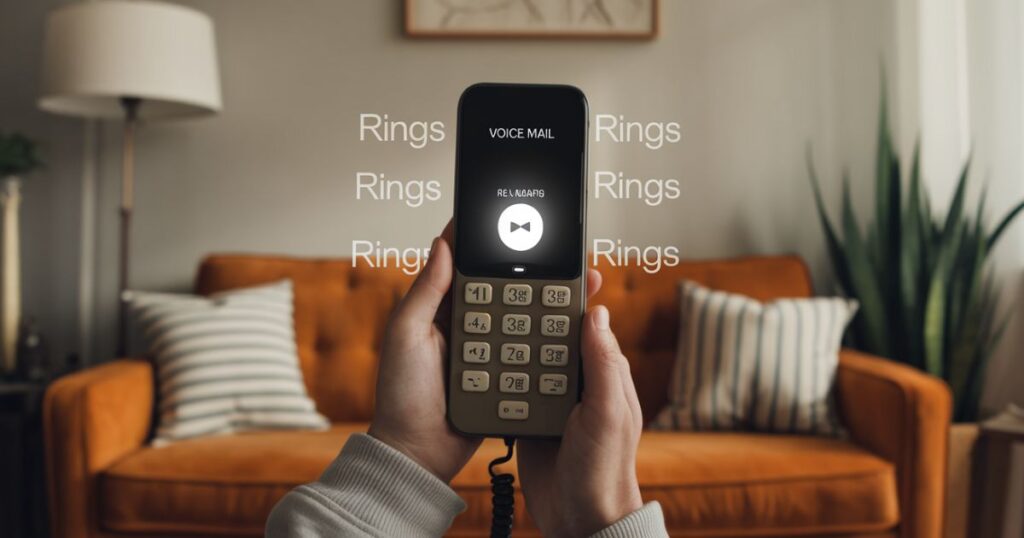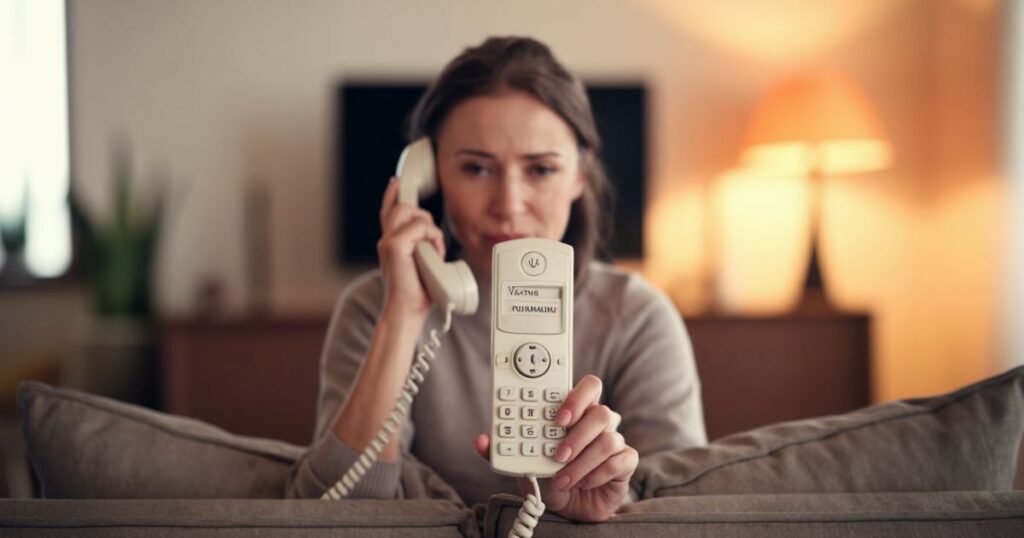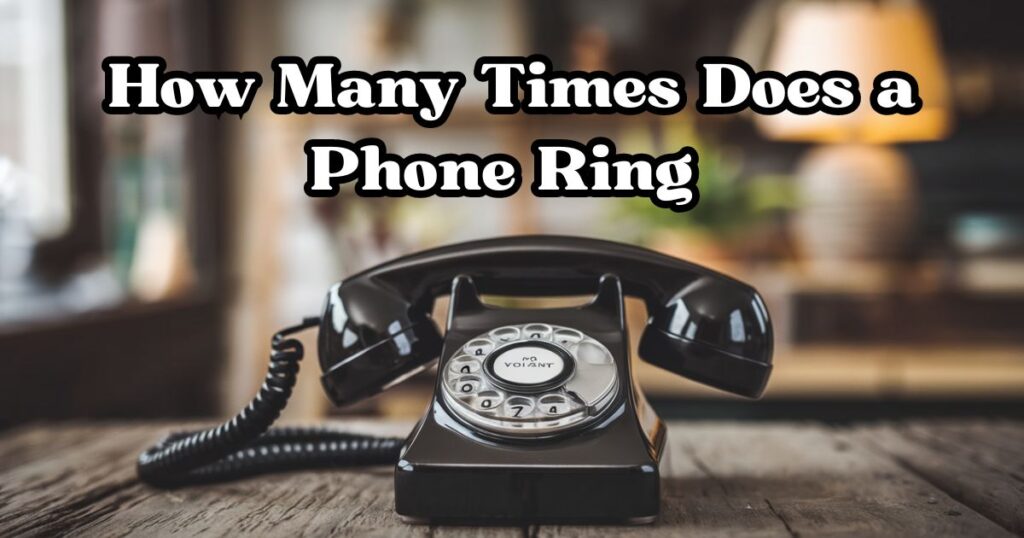The humble phone ring still holds a special place in our hyper-connected world. It’s that moment of anticipation, the digital drum roll before we connect with someone. But have you ever wondered about the science and etiquette behind those rings?
Let’s move into the interesting world of phone rings, voicemail, and the intricate dance of network signals that happens every time we make a call.
Key Takeaways
- The process from dialing a number to hearing a voice or reaching voicemail is more complex than it seems.
- Phones in the USA typically ring 4 to 6 times before going to voicemail.
- This process involves a sophisticated digital handshake between your device and the cellular network.
- The number of rings can indicate availability, urgency, and even relationship dynamics.
- Ring patterns can vary based on your carrier, phone model, and personal settings.
- iPhone and Android users have more control over their phone’s behavior than they may realize.
- Understanding phone settings can enhance your communication experience.
- It’s not just about answering calls; it’s about customizing your digital presence.
How Many Times Does A Phone Ring Before the Call Is Forwarded, Goes To Voicemail or Disconnects?

The magic number of rings before a call takes a detour to voicemail isn’t as straightforward as you might think. In the intricate world of call forwarding and network signals, most US carriers have their systems set to allow about 4 to 6 rings before they wave the white flag and usher the call into the voicemail zone.
But here’s where it gets interesting: each “ring” you hear isn’t just a simple sound. It’s actually a complex, roughly 6-second long process where your phone and the network are engaged in a sophisticated tango of data exchange.
For the tech-savvy crowd, particularly Android users, this is where things get exciting. Android settings often provide a playground for users to tinker with call forwarding options.
This means you can actually be the maestro of your own ring patterns, deciding just how patient (or impatient) your phone should be before it decides to send callers to voicemail. It’s like having a secret control panel for your personal telecommunications system, allowing you to fine-tune your accessibility to match your lifestyle and preferences.
The Science Behind the Ring: What’s Really Happening?
Behind the scenes of every phone call is a marvel of modern technology. When someone calls your number, it kicks off a lightning-fast relay race across the cellular network.
Your phone and the network engage in a rapid-fire conversation, a digital handshake that determines whether your device should ring or if the caller should be gently guided to your voicemail. This process is a testament to the incredible speed and efficiency of our modern communication infrastructure, all happening in the blink of an eye.
Read More: Influencers Gonewild: Hidden Truths Shaking Social Media in 2024
If You Call Someone and Their Phone Is Off, Will It Ring?
The phenomenon of calling a powered-off phone presents an interesting quirk in the world of telecommunications. Even when dialing a number belonging to a device that’s taking a siesta, you might still hear a ring or two. But don’t be fooled – this isn’t your friend’s phone magically coming to life.
It’s actually the cellular network performing a quick check to see if the device is available. This clever system ensures that callers aren’t left in limbo, wondering if their call is going through or not.
What you’re hearing in these cases is the network’s way of maintaining the illusion of normalcy. It’s a bit like a digital sleight of hand, designed to provide a seamless experience for callers.
Behind the scenes, the network is rapidly determining the phone’s status and deciding whether to route the call to voicemail or play a message informing you that the device is unavailable. This process happens in mere seconds, showcasing the impressive efficiency of modern cellular networks.
How Many Times Should A Phone Be Allowed to Ring Before It’s Answered?
The question of ideal ring duration treads the fine line between telephonic etiquette and practical necessity. In the United States, cultural norms generally suggest that allowing a phone to ring 4 to 6 times strikes a good balance.
This duration gives the recipient ample time to reach their phone without leaving the caller hanging for an eternity. It’s a social contract of sorts, an unspoken agreement in our digital communication landscape.
However, the “right” number of rings can vary depending on context. In professional settings, answering promptly (within 2-3 rings) is often seen as courteous and efficient. On the personal front, some argue that letting a call ring longer shows patience and respect for the recipient’s time.
The key is to find a balance that works for your lifestyle and relationships. Remember, your ring patterns can say a lot about you – they’re like your digital body language, conveying availability and attentiveness without saying a word.
The Golden Rule of Rings: Finding the Sweet Spot
Finding the perfect ring duration is like discovering the Goldilocks zone of telecommunications – not too short, not too long, but just right. The ideal scenario allows enough time for the recipient to comfortably reach their phone without leaving the caller in a state of prolonged uncertainty.
Consider factors like your typical surroundings, daily routine, and the nature of calls you usually receive. For instance, if you often take important business calls, you might opt for a shorter ring time to convey promptness and professionalism.
How Many Times Does a Phone Ring When You’re Blocked?
The telltale signs of being blocked on someone’s phone can be subtle but distinct. When you’re blocked, the behavior of the call can vary depending on the phone model and carrier, but there are some common patterns. Often, you’ll experience a shortened ring pattern – perhaps just one ring before being diverted to voicemail.
In some cases, you might not hear any rings at all, instead going straight to voicemail or receiving a message that the call cannot be completed. It’s important to note that these signs aren’t always definitive proof of being blocked. Similar behaviors can occur if the recipient’s phone is off, in airplane mode, or in an area with poor reception. The key difference often lies in consistency.
If you consistently experience these shortened ring patterns or immediate diversions to voicemail, especially if you know the person’s phone is typically on and in service, it might indicate that you’ve been blocked. However, it’s always best to avoid jumping to conclusions and consider other possibilities before assuming you’ve been blocked.
| Scenario | Typical Ring Behavior | What It Might Mean |
| Normal Call | 4-6 rings | Phone is on and available |
| Blocked Call | 0-1 rings or immediate voicemail | Possibly blocked or phone is off |
| Do Not Disturb | Varies (often 1 ring then voicemail) | Phone is set to limit disturbances |
| Poor Reception | Inconsistent ringing or no connection | Network issues or phone is out of range |
How Many Times Does A Phone Ring If The Call Is Ignored?
When a call is actively ignored (for example, when someone hits the “decline” button), the experience for the caller can be quite different from a call that simply goes unanswered. In most cases, when a call is ignored, it’s cut off more abruptly than if it were to ring through to voicemail. The number of rings you hear might be cut short – perhaps just one or two before the call ends.
This quick cutoff is a result of the recipient’s phone sending a signal back through the network to end the call immediately. It’s worth noting that the behavior can vary slightly between different phone models and operating systems. For instance, some Android settings allow users to customize how ignored calls are handled.
They might choose to send certain numbers straight to voicemail without any rings, or to let the call ring a set number of times before cutting it off. iPhones, on the other hand, tend to have a more standardized behavior when ignoring calls.
Understanding these nuances can help you interpret the signals you’re receiving when you call someone, giving you a better sense of whether your call is being deliberately ignored or if other factors are at play.
The Art of the Ignore: What Your Phone Does Behind the Scenes
When you choose to ignore a call, your phone performs a series of quick actions in the background. First, it sends a signal through the cellular network to terminate the connection with the incoming call. Simultaneously, it may log the call in your recent calls list and, depending on your settings, might send an automated text message to the caller.
Some phones even offer the option to set custom responses for ignored calls, allowing you to communicate your unavailability without picking up. This behind-the-scenes process is a testament to the sophistication of modern smartphones and their ability to manage our communications efficiently.
Phone Rings 4 Times Then Voicemail? What to do

A phone that consistently rings four times before going to voicemail is often operating on default settings. This standard setting is designed to give recipients a reasonable amount of time to answer while not keeping callers waiting too long. If you find that four rings aren’t sufficient for your needs, don’t worry – this setting can usually be adjusted.
Most cellular networks and phone systems allow users to customize the number of rings before a call is forwarded to voicemail. To change this setting, you’ll need to dive into your phone’s settings or contact your carrier. For Android users, the path to adjust ring duration can vary depending on your phone model, but it’s typically found in the Phone or Call Settings menu.
iPhone users might need to contact their carrier directly to change this setting, as it’s often controlled at the network level. Remember, finding the right balance is key – too few rings might mean missed calls, while too many could frustrate callers or lead them to hang up before leaving a message.
Breaking the 4-Ring Curse: Customizing Your Call Experience
Customizing your ring duration is about more than just changing a number – it’s about tailoring your phone’s behavior to fit your lifestyle. Consider your daily routine: Are you often in meetings where a longer ring time might be disruptive? Or maybe you’re frequently moving between quiet and noisy environments, needing extra time to hear your phone.
Some people even use ring duration as a subtle communication tool, setting longer ring times for close contacts and shorter ones for unknown numbers. Experimenting with these settings can help you find the perfect balance between accessibility and personal peace.
Phone Rings Twice Then Goes To Voicemail? What to do
When your phone constantly rings only twice before diverting to voicemail, it’s often a sign that your call forwarding settings need attention. This shortened ring pattern can be frustrating for both callers and recipients, potentially leading to missed connections and communication hiccups. The good news is that this issue is usually easily resolvable with a few tweaks to your phone or network settings.
First, check your phone’s Do Not Disturb or silent mode settings – these can sometimes cause calls to be prematurely sent to voicemail. If those aren’t the culprit, the next step is to examine your call forwarding settings. On Android devices, you can usually find these in the Phone app under Settings > Calls > Call forwarding or a similar path.
For iPhone users, call forwarding settings are typically managed through your carrier, so you might need to contact them directly or check their app or website for customization options. Adjusting these settings can help ensure that your phone rings for an appropriate duration, giving you ample time to answer calls without keeping callers waiting too long.
The Two-Ring Tango: Balancing Accessibility and Privacy
Finding the right balance between being accessible and maintaining your privacy can be tricky. A two-ring setting might be perfect for some situations – perhaps you’re expecting an important call and want to respond quickly, or you’re in a position where prolonged ringing would be disruptive. However, for most people, this setting is too short.
Consider adjusting your ring duration to a happy medium – perhaps 3-4 rings. This gives you enough time to answer while still respecting your callers’ time. Remember, your ring settings are a form of non-verbal communication, signaling to callers how available you are. Tailoring these settings thoughtfully can help you manage your communications more effectively.
How to Change Number of Rings on iPhone Before Voicemail

Adjusting the number of rings on an iPhone before calls go to voicemail requires a slightly different approach compared to Android devices. Unlike many Android phones where you can change this setting directly on the device, iPhones often rely on carrier-level settings for ring duration. This means the process might vary depending on your service provider, but don’t worry – it’s still manageable with a few simple steps.
To change your iPhone’s ring count, start by checking your carrier’s app or website. Many major carriers allow you to adjust these settings through their customer portal. If you can’t find the option there, the next step is to contact your carrier’s customer service. They can usually adjust the ring duration for you remotely. Some carriers also offer a code you can dial on your iPhone to change these settings yourself.
For example, you might be able to dial something like *#61# to access your call forwarding settings. Once you’re in the right menu, look for options related to “call forward no answer” or “set ring duration.” Remember, the exact steps and options may vary by carrier, so don’t hesitate to reach out to your provider for specific guidance.
| Carrier | Method to Change Ring Duration |
| Verizon | My Verizon app or website, or dial *71 |
| AT&T | myAT&T app or website, or contact customer service |
| T-Mobile | T-Mobile app or website, or dial *#61# |
| Sprint | My Sprint app or website, or contact customer service |
Conclusion
In conclusion, understanding and customizing your phone’s ring behavior is more than just a technical exercise – it’s about taking control of your digital communication style. Whether you’re adjusting ring patterns, managing call forwarding, or fine-tuning your voicemail settings, each choice reflects your personal and professional needs.
By mastering these aspects of telephonic etiquette, you’re not just optimizing your device; you’re crafting your unique presence in the digital realm. So go ahead, dive into those settings, and make your phone work for you – your perfect ring awaits!

